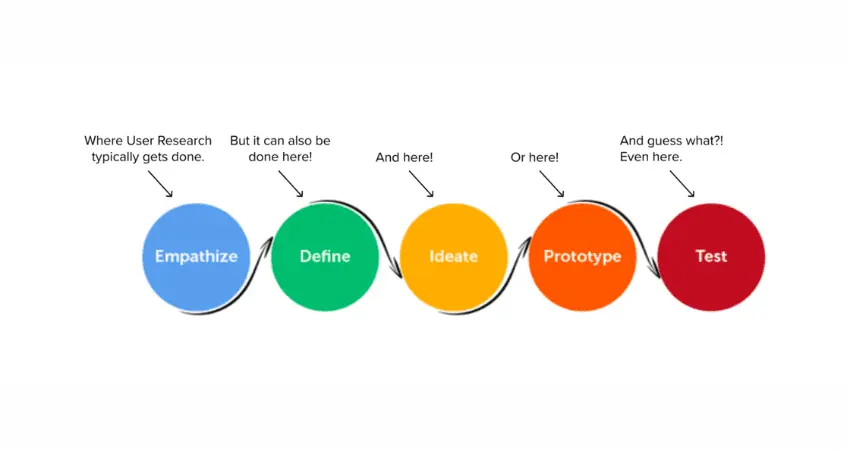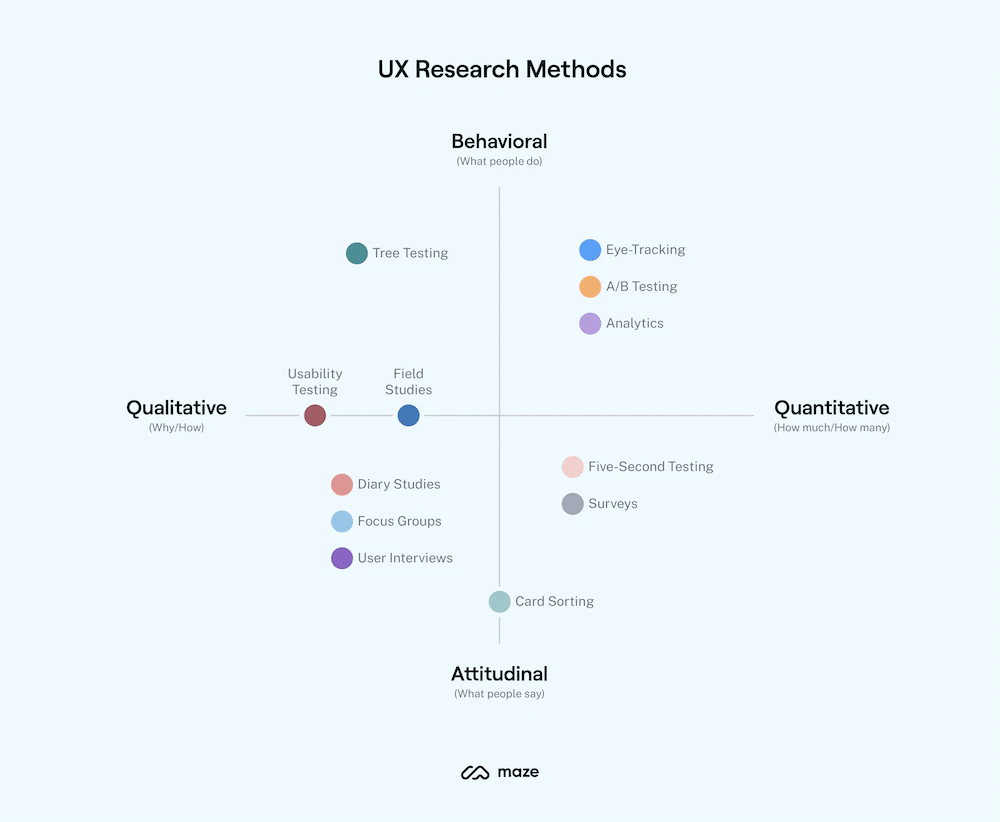UX Research Methods: Types, Examples, and How to Choose the Best One

There is a wide range of research methods available, from tried-and-true methods (such as lab-based Usability Testing) to those that have been developed more recently (such as Unmoderated Testing). Here, we will explain the 20 most commonly used methods.
User Experience (UX) design is the process of creating products that are useful, easy to use, and enjoyable to engage with. It’s about enhancing the entire experience that people have when interacting with a product and ensuring they find it useful and satisfying.
If the peak of a mountain represents that goal, employing various UX research methods is the path UX designers take to reach the top.
Every product, service, or user interface that designers create in the safety and comfort of their workplaces must survive and thrive in the real world.
To conduct UX research effectively and gain a clear picture of what users think and why they do what they do, it is essential that teams conduct user research frequently and regularly.
What are UX research methods?
The field of user experience offers a wide range of research methods, from tried-and-true techniques, like lab-based Usability Testing, to more recently developed methods, like Unmoderated Testing.
While it’s unrealistic to use the full set of methods in a given project, nearly every project would benefit from employing multiple research methods and combining insights. Unfortunately, many design teams only use one or two methods with which they are most familiar.
The key question is what to use and when. To better understand when to use which method, it’s helpful to view them across a framework with the following axes:
Qualitative Methods vs. Quantitative Methods
Attitudinal Methods vs. Behavioral Methods
Qualitative Methods vs. Quantitative Methods
Qualitative studies generate data about behaviors or attitudes based on directly observing or listening to users, whereas quantitative studies collect data on behavior or attitudes indirectly, through a measurement or instrument like a survey or an analytics tool.
Due to the nature of their differences, qualitative methods are much better suited to answering questions about why or how to solve a problem, while quantitative methods are far better at answering questions about when and how much.
Having those numbers helps prioritize resources, for example, by focusing on the highest-impact issues.
Examples of Qualitative Methods:
Usability Testing
User Interviews
Field Studies
Focus Groups
Examples of Quantitative Methods:
A/B Testing
Surveys
Analytics
Clickstream Analytics
Attitudinal Methods vs. Behavioral Methods
This distinction can be summarized by contrasting "what people say" versus "what people do" (often, the two are quite different). The purpose of attitudinal research is usually to understand or measure people's stated beliefs, but it is limited by what people know and are willing to report.
Examples of Attitudinal Methods:
Surveys
Focus Groups
Card Sorting
Examples of Behavioral Methods:
A/B Testing
Eye Tracking
Analytics
Clickstream Analytics

The Top 20 UX Research Methods and When to Use Them
Usability Testing: Participants are brought into a lab, one-on-one with a researcher, and given a set of scenarios that lead to specific tasks and usage within a product or service.
Field Studies: Researchers study participants in their own environment (work or home), where they are most likely to encounter the product or service, in the most realistic or natural setting possible.
Contextual Inquiry: Researchers and participants work together in the participants' own environment to investigate and observe the nature of the tasks and work at hand. This method is very similar to a Field Study and was developed to study complex systems and processes in depth.
Participatory Design: Participants are given design elements or creative materials to construct their ideal experience in a concrete way that expresses what matters most to them and why.
Focus Groups: Groups of 3 to 12 participants are guided through a discussion on a set of topics, providing verbal and written feedback through discussions and exercises.
User Interviews: A researcher meets with participants one-on-one to discuss in depth what the participant thinks about the topic at hand.
Eye Tracking: An eye-tracking device is set up to accurately measure where participants look while performing tasks or naturally interacting with websites, apps, physical products, or environments.
Usability Benchmarking: Usability studies are conducted with strict scripts and a larger number of participants, using precise and predetermined performance measures, usually with the goal of tracking usability improvements over time or comparing them with competitors.
Remote Moderated Testing: Usability studies are conducted remotely, using tools such as video conferencing, screen-sharing software, and remote control capabilities.
Unmoderated Testing: An automated method that can be used in both quantitative and qualitative studies, using a specialized research tool to capture participants' behaviors and attitudes, usually by providing them with goals or scenarios to achieve with a site, app, or prototype. The tool can record a video stream of each user session and can collect usability metrics such as success rate, task time, and perceived ease of use.
Concept Testing: A researcher shares an approximation of a product or service that captures the key essence (the value proposition) of a new concept or product to determine if it meets the needs of the target audience. This can be done one-on-one or with a larger group of participants, either in person or online.
Diary Studies: Participants use a mechanism (e.g., a paper or digital diary, a camera, a smartphone app) to record and describe aspects of their lives that are relevant to a product or service or simply fundamental to the target audience. Diary studies are usually longitudinal and can only be conducted with data that participants can easily record.
Customer Feedback: Open or closed information provided by a self-selected sample of users, often through a feedback link, button, form, or email.
Desirability Studies: Participants are offered different visual design alternatives and are expected to associate each alternative with a set of attributes selected from a closed list. These studies can be both qualitative and quantitative.
Card Sorting: A quantitative or qualitative method that asks users to organize items into groups and assign categories to each group. This method helps create or refine a site's information architecture by exposing users' mental models.
Tree Testing: A quantitative method for testing an information architecture to determine how easy it is to find items in the hierarchy. This method can be conducted on an existing information architecture to compare it and then again, after the information architecture is improved with Card Sorting, to demonstrate improvement.
Analytics: Analysis of data collected from user behavior, such as clicks, form fills, and other recorded interactions. It requires the site or app to be properly instrumented in advance.
Clickstream Analytics: A particular type of analysis that involves examining the sequence of pages users visit while using a site or software application.
A/B Testing: A method for scientifically testing different designs on a site by randomly assigning groups of users to interact with each of the different designs and measuring the effect of these assignments on the user.
Surveys: A quantitative measure of attitudes through a series of questions, typically more closed-ended than open-ended. Participants are usually recruited via an email message or contacted through some other channel, such as social media.
How to Choose the Right UX Research Method?
Choosing the right research method starts with knowing what problem you're trying to solve and what type of data you need to collect. You might want to look for UX research templates or read about research examples. A good way to inform your choice of method is to start by considering what you want the outcome of your research to be.
In his talk on how to conduct research that has a real impact, Michael Margolis, UX research partner at Google Ventures, says that conducting effective research begins with defining the questions you're trying to answer.
Here are some questions Michael suggests answering before starting your research:
What do your users need?
What are your users struggling with?
How can you help your users?
For Nannearl LeKesia Brown, product researcher at Figma, choosing the research method depends on the research goal, the stage you're at in the design process, and the resources available:
What do we already know?
What remains to be discovered?
Is it a new feature, or is it an existing feature we want to improve?
So, when selecting a UX research method, consider your goals, resources, and timeline. Identifying these things early on will help you choose the right method for you.
Reasons to Conduct UX Research
Here are three major reasons to conduct user research:
1. To create a product that is truly relevant to users.
If you don’t have a clear understanding of your users and their mental models, you have no way of knowing if your design will be relevant. A design that isn’t relevant to your target audience will never be successful.
2. To create a product that is easy and enjoyable to use.
A favorite quote from Steve Jobs: "If the user has a problem, it’s our problem." If their user experience isn’t optimal, people are likely to switch to another product.
3. To validate the return on investment (ROI) of UX design.
Improved business performance and credibility**
Increased exposure and sales:** Growth of the customer base
More efficient work processes**
Aside from the reasons mentioned above, conducting user research provides insight into which features to prioritize and generally helps develop clarity around a project.
What results can I expect from UX research?
Joe Gebbia, CEO of Airbnb, is an enthusiastic advocate and testifies that its implementation helped turn things around for the company when it was struggling as a startup.
Some of the outcomes generated through UX research confirm that improving the usability of a site or app serves to:
Increase conversion rates
Increase subscriptions
Increase NPS (Net Promoter Score)
Increase customer satisfaction
Increase purchase rates
Increase brand loyalty
Reduce customer support calls
In addition to benefiting the overall user experience, integrating UX research into the development process can:
Minimize development time
Reduce production costs
Uncover valuable insights about your audience
Offer an in-depth view of users' mental models, pain points, and goals
A Handcrafted Science
While many user experience research methods have roots in scientific practice, their goals are not purely scientific and still need to be adjusted to meet stakeholder needs.
As the name suggests, UX is subjective: it is the experience that a person goes through while using a product. Therefore, it is necessary to understand the potential users' needs and goals, the context, and their tasks, which are unique to each product.
By selecting the appropriate UX research methods and applying them rigorously, designers can shape the design of a product and create products that serve both customers and businesses more effectively.


